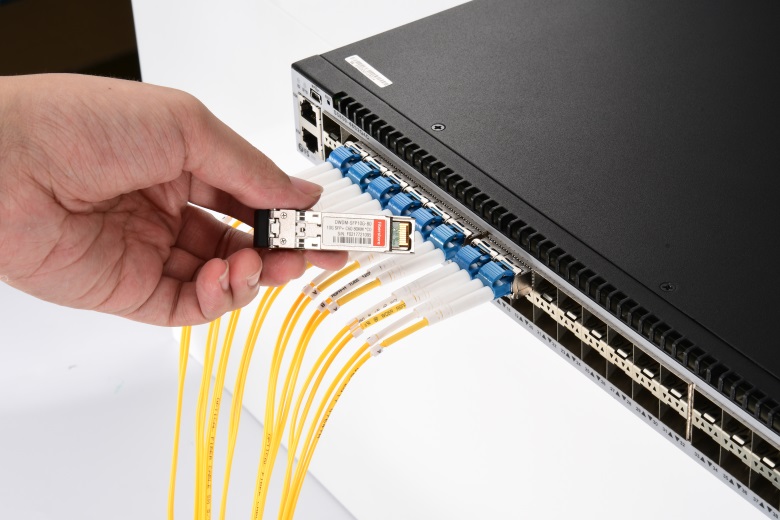The demand for high speed data transfer over long distances has been increasing exponentially with the growth of telecommunication networks, cloud computing and data centers. Traditional copper wire based networks have limitations in terms of bandwidth capacity and range that can restrict this demand. Optical fiber networks using fiber optic cables have emerged as the preferred medium for high speed, high capacity long haul data transmission. At the core of enabling data transfer over these optical fiber networks are optical transceivers.
What are Optical Transceivers?
An Optical Transceiver is a network component that contains both a transmitter and receiver in a single unit. The transmitter converts an electrical signal from network equipment like routers, switches etc. into an optical signal using laser diodes. The receiver then converts the received optical signal back into an electrical signal.
Types of Optical Transceivers
There are different types of optical transceivers used depending on factors liketransmission speed, transmission range, fiber type and physical form factor. Some common types are:
– SFP/SFP+: Small Form-factor Pluggable transceivers commonly used in speeds up to 10Gbit/s over multi-mode and single-mode fiber. They have a compact pluggable module format.
– XFP: 10 Gigabit Small Form Factor Pluggable transceivers used in speeds up to 10Gbit/s. Larger in size than SFP/SFP+.
– SFP28: Newer pluggable formats for 25Gbit/s and higher speeds over single-mode fiber.
– CFP/CFP2/CFP4: CForm-factor Pluggable transceivers used for higher port-level aggregation and speeds from 40Gbit/s up to 400Gbit/s.
– QSFP/QSFP28: Quad Small Form-factor Pluggable transceivers for speeds between 40Gbit/s to 100Gbit/s.
Advantages of Optical Transceivers
Some key advantages of using optical transceivers for high speed data transmission include:
– High Bandwidth Capacity: Optical fiber provides bandwidth in the order of Terabits per second owing to its extremely high carrier frequencies of optical waves. This enables transmission of huge volumes of data.
– Long Transmission Distances: Optical signals experience very low transmission losses as they travel through fiber. This allows transmission over hundreds of kilometers without any repeater stations.
– Immunity to Electrical Noise: Being an optical transmission system, it is not affected by electromagnetic interference that can corrupt or degrade copper wire signals.
– Scalability: The bandwidth capacity of optical fibers can be easily scaled further by implementing technologies like dense wavelength division multiplexing (DWDM).
– Security: As light signals cannot be easily detectedexcept at receiver, optical transmission provides better security against tapping of signal compared to radio waves.
– Low Maintenance: Optical fiber networks have negligible maintenance needs once deployed compared to copper cables requiring periodical repairs or replacement.
Working Mechanism of Optical Transceivers
A brief overview of the working of an optical transceiver is as follows:
– At the transmitting end, serial electrical signals from a network device enter the transceiver module. An electronic driver circuit conditions the signals.
– Lasers inside the transceiver like VCSEL (Vertical Cavity Surface Emitting Lasers) or DFB (Distributed Feedback Lasers) are activated based on the electronic signal levels to generate corresponding optical signals.
– The optical signals from multiple such laser sources carrying different data are multiplexed using techniques like dense wavelength division multiplexing (DWDM) to carry them through a single fiber strand.
– At the receiving end, a PIN (Positive-Intrinsic-Negative) photodiode detects the incoming light signals inside the transceiver module.
– A receiver circuit then amplifies and reconditions the converted electrical signals before sending them to the destination network device.
– Optical-electrical and electrical-optical conversions take place seamlessly inside the transceiver module bridging optical and electronic domains.
Applications of Optical Transceivers
Some major applications of optical transceivers include:
– Long haul telecommunication networks: Undersea cables and worldwide backbone networks rely on transceivers for transcontinental data transmission.
– Data centers: Switch-to-server, server-to-server and rack-to-rack connectivity in modern hyperscale data centers uses optical transceivers extensively.
– High performance computing: Transceivers enable high bandwidth interconnects between computing blades and storage within HPC clusters.
– Fiber to the x (FTTx): Passive optical networks (PON) for broadband fiber to the home/business/curb use transceivers in fiber nodes.
– 5G networks: Fronthaul and backhaul networks for 5G rely on optical transport using numerous transceiver installations.
– Artificial intelligence: Transceivers facilitate transfer of massive real-time and non-real time datasets required for AI/ML modeling across cloud and edge.
In conclusion, optical transceivers have emerged as the backbone technology powering the increasingly data-driven digital world. By enabling seamless transition between optical fiber and electronic domains, transceivers facilitate transmission of ever increasing data volumes at high speeds through vast optical networks supporting cloud, telecom and broadband services. Technological advancements will further scale transceiver capacities to meet the relentless demands of 5G, artificial intelligence and future applications.
*Note:
1. Source: Coherent Market Insights, Public sources, Desk research
2. We have leveraged AI tools to mine information and compile it




